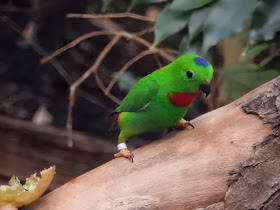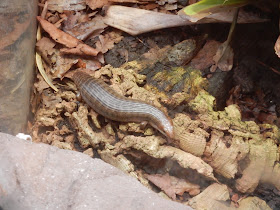Having heard many good things about the Chester Zoo, it was only a matter of time before I planned a trip there. I was very impressed by both the exhibit design and collection of rarely-seen species. I took more than enough photos to split this trip report into several separate posts, but I unfortunately don't have time to write more than one at the moment, so a highlights reel will have to do.
It's not every zoo where you get to see an Indian rhinoceros right off the bat.
A nearby aviary houses several bird species, including northern bald ibises. This is such a large aviary that unless the birds are standing right next to the viewing area, it can be difficult to see them clearly without binoculars! (Luckily, I almost always carry a pair with me.)
Cinereous vultures also live in this aviary. (This one was cooperatively standing near the mesh.)
I spent a good amount of time in the Tropical Realm building, which houses numerous species of free-flying tropical birds. If this hadn't been my first trip to the zoo, I probably could have been persuaded to spend most of my day there just looking for all the species. (I did end up seeing most of them.) Here is a Palawan peacock pheasant.
A Madagascar fody taking a bath while a Java sparrow and a red-billed leiothrix look on.
A sunbittern on a light fixture.
In addition to the free-flying birds, lining the walls of the Tropical Realm are separate aviaries housing even more species. Here is a pink pigeon. In 1991, only ten individuals of this Mauritian bird were left and it was considered critically endangered. Thanks to successful conservation efforts, its conservation status has been downlisted to vulnerable.
A great hornbill, one of the largest hornbills. Chester Zoo has a great collection of hornbills; I counted at least five species on my visit (great, Visayan, wrinkled, rhinoceros, and red-billed).
Not a hornbill, but a toucan. A green aracari, to be specific.
Two blue-naped mousebirds. Picking favorite birds is always difficult for me, but mousebirds have to be high on the list for their distinctiveness and their rich Paleogene fossil record.
A Congo peafowl, a species that wasn't scientifically described until the 20th Century.
A superb fruit dove.
A blue-necked tanager.
A pair of collared trogons.
The Tropical Realm also contains exhibits for amphibians, such as this false tomato frog.
There are non-avian reptiles as well, like this Graham's anole.
The species I'd most wanted to see at Chester though was the tuatara, and I'm happy to report that my wish was granted! I've now seen the world's only extant rhynchocephalian.
I also saw bush dogs for what I think is the first time. These small South American canids are very social, allowing them to prey on animals larger than themselves. They are housed in a different tropics-themed exhibit, the Spirit of the Jaguar.
In general, I liked the exhibit signage at the Chester Zoo (as we shall see), but one of the accompanying signs for the bush dogs did contain a glaring error. (Coatis are not rodents.) (Update: Surprisingly, the outreach team at the zoo responded to my tweet about this and has said they're working on fixing this. Huzzah!)
Yet another tropics-themed exhibit is the Realm of the Red Ape, a two-story building that allows visitors to view orangutans and gibbons high above ground. It was quite impressive, but I was more distracted by the blue-crowned hanging parrots, and can you blame me?
Upon exiting the Realm of the Red Ape, the zoo suggests several animal-themed recipes that make use of products with sustainable palm oil.
A babirusa showing off its unusual upwards-curving tusks.
This red forest duiker is exhibited alongside okapis. No doubt it gets regularly mistaken for a juvenile okapi by visitors.
Dragons in Danger is another indoor exhibit, this time named after its Komodo dragons. However, it also houses a variety of other animals, including many Southeast Asian birds. Due to the dense vegetation and dim lighting, the birds were quite hard to spot, but I did see this (very loud) Asian fairy bluebird.
Nearby is a surprisingly large exhibit for giant Hispaniolan galliwasps (shared with mountain chickens, a type of frog).
Islands is a relatively new exhibition area at Chester (having opened in 2015), and it features animals from Southeast Asian islands and New Guinea, such as this southern cassowary.
Islands also includes a walkthrough aviary for even more Southeast Asian birds, including the critically endangered Bali myna. Unfortunately, one of the other major exhibits at Islands, the Monsoon Forest, was partially destroyed by a fire in December 2018. Most of the inhabitants were rescued and relocated to other parts of the zoo, but a number of smaller animals did not make it.
A large chunk of the Chester Zoo is devoted to African animals. Here is a black stork, part of a large wetland aviary.
A black crowned crane (with a wild magpie in the background that I hadn't noticed until after I took the picture).
Nearby are these wattled cranes, the largest cranes in Africa.
Some African wild dogs.
Rock hyraxes (with babies)!
Despite the gaffe with coatis shown earlier, I liked how informative many of Chester's exhibit signs were. I especially appreciated this sign at the hyrax exhibit.
Naturally, there is a walkthrough aviary in this part of the zoo as well. Here, a village weaver works on its nest.
A snowy-crowned robin chat, a skilled vocal mimic of other birds.
A hamerkop, a wading bird known for building massive nests that can be more than one meter across. Some of these nests were evident in the exhibit.
Africa is home to several spectacular starlings, including this aptly-named superb starling.
A blacksmith lapwing.
Some crested guineafowl (as opposed to the more commonly kept helmeted guineafowl).
Although the African aviary isn't especially large or densely-planted, many birds remained surprisingly well hidden. Fortunately, some keepers passed through while I was there and scattered some mealworms on the ground, which drew out a few of the shier birds. One of the birds that emerged to check out the commotion was this red-winged starling.
This lilac-breasted roller also showed up, to my delight.









































No comments:
Post a Comment